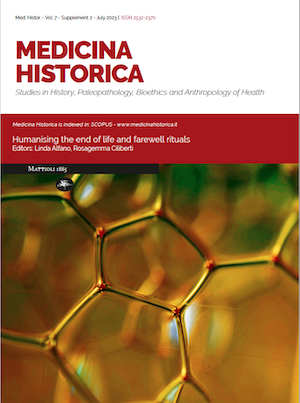A bridge between the protection of future generations and the preservation of human remains in museums
Keywords:
Unesco, Universal Declaration on Bioethics and Human Rights, future generations, museum, human remains, ethicsAbstract
Unesco's approach to safeguarding future generations through the Universal Declaration of Bioethics and Human Rights provides a significant framework for examining the preservation of human remains in museums. Understanding this practice in the light of ethics, science and culture is essential to ensure that future generations can learn from the past without compromising respect for the deceased and their traditions. Through balanced reflection and active engagement of stakeholder, a respectful and informative approach to the preservation of human remains in museums can be created for a future enriched by knowledge and understanding of the past. Through a multidisciplinary approach that involves experts in bioethics, anthropology, history, and cultural studies, museums can develop comprehensive policies for the respectful curation and display of human remains.
References
Licata M, Larentis O, Tesi C, Fusco R, Ciliberti R. Tourism in the Time of Coronavirus. Fruition of the “Minor Heritage” through the Development of Bioarchaeological Sites. A Pro-posal. Heritage 2021; 4:759–74.
Bergel SD. Ten years of the Universal Declaration on Bioethics and Human Rights. Rev bioét 2015; 23(3):446–55.
Salako SE. The UNESCO Universal Declaration on Bioethics and Human Rights: protecting future generations and the quest for a global consensus. Med Law 2008;27(4):805–23.
Larentis O, Tonina E, Tesi C, Rossetti C, Gorini I, Ciliberti R, Licata M. A probable case of subligamentous tuberculous spondylitis: The concealed body of the Late Modern Period (early 16th century to early 20th century), Franciscan crypt of St. Anthony and St. Eusebius church, Lombardy, Italy. Int J Osteoarchaeol 2020; 30(2):180–96.
Ciliberti R, Bonsignore A, Molinelli A, Ventura F, Licata M. How Italy has moved from anatomical studies in the sixteenth century to body donation in the twenty-first century. Ann Ital Chir 2020; 91(1):1–7.
Patuzzo S. Ciliberti R. Medical humanities. Recognition and reorganization within the Italian university. Acta Biomed 2018; 88 (4):512–3.
Gulino M, Patuzzo S, Baldelli I, Gazzaniga V, Merlo DF, Maiorana L, Murialdo G. et al. Bioethics in Italian medical and healthcare education. A pilot study. Acta Biomed 2018; 89(4):519–31.
Ciliberti R, Armocida G, Licata M. Rebury the “atavistic skull” studied by Lombroso? Am J Forensic Med Pathol 2019; 40(2):136–9.
Licata M, Bonsignore A. Boano R, Monza F, Fulcheri E, Ciliberti R. Study, conservation and exhibition of human remains: The need of a bioethical perspective. Acta Biomed 2020; 91(4):e2020110.
Monza F, Licata M. I preparati anatomici nei musei una particolare categoria di beni culturali. Med Secoli 2015; 27(2):615–28.
Downloads
Published
Issue
Section
License
This is an Open Access article distributed under the terms of the Creative Commons Attribution License (https://creativecommons.org/licenses/by-nc/4.0) which permits unrestricted use, distribution, and reproduction in any medium, provided the original work is properly cited.
Transfer of Copyright and Permission to Reproduce Parts of Published Papers.
Authors retain the copyright for their published work. No formal permission will be required to reproduce parts (tables or illustrations) of published papers, provided the source is quoted appropriately and reproduction has no commercial intent. Reproductions with commercial intent will require written permission and payment of royalties.

This work is licensed under a Creative Commons Attribution-NonCommercial 4.0 International License.

